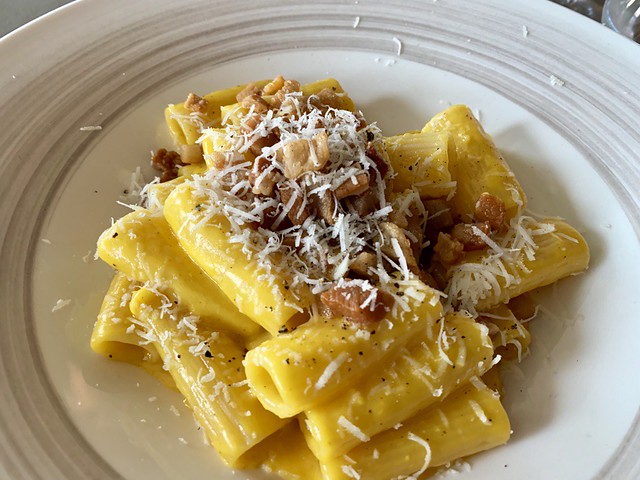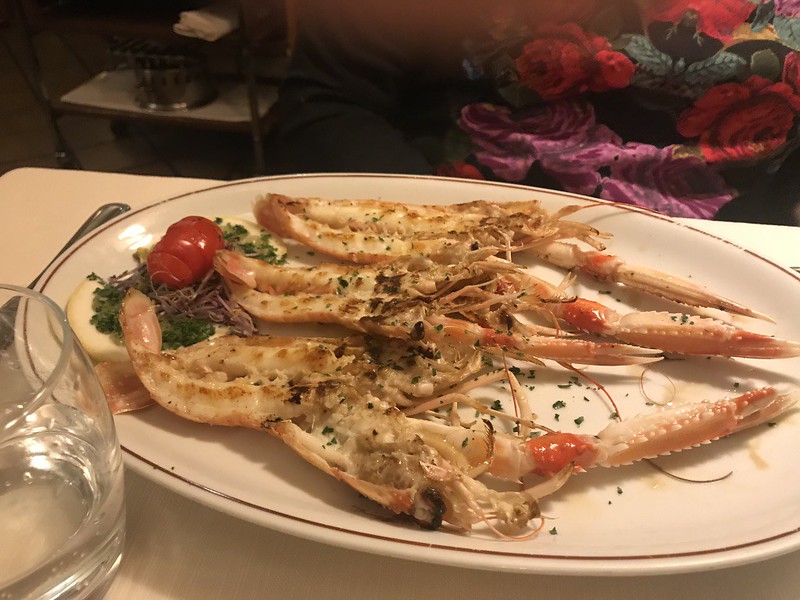With its wealth of spectacular art, architecture, and archaeological treasures, it’s easy to forget that Italy’s capital city is also a culinary destination in its own right. From casual street food stands to elegant Michelin-starred restaurants, Rome can satisfy any palate (and budget) — but the bustling neighborhood trattorias are where the Eternal City’s local dishes really shine.

Roman cuisine reflects the spirit of the city itself: apparently straightforward and easygoing but subtly fussy about the details and resistant to change. The recent_dust-up over a doctored recipe for one of Rome’s most iconic dishes in the New York Times was an entertaining reminder of how attached Romans are to their historic dishes, vestiges of the city’s strong roots in the surrounding countryside and scrappy culture of survival over the past few centuries.
After watching the latest episode of “Stanley Tucci: Searching for Italy” focused on Rome, we realize that we’ve been remiss in highlighting this captivating city’s excellent food. Some of our most memorable meals over the years have been in Rome and we’ve gotten into the habit of staying in the city a couple of nights before we fly home to the USA on each trip, as it allows us to catch an early flight from Fiumicino and gives us a chance to check out new hotels and restaurants.
We have two close Roman friends, Maura and Carlo, who sing in the Coro di Santa Cecilia and love food as much as we do. They usually join us for dinner at restaurants that we’re looking to try in the more touristy area of the city center so we can get an honest assessment from hard-to-please locals. If Maura and Carlo give their seal of approval, we know we can add the eatery to our list of recommendations!

“When I eat at a trattoria,” says Brian, “I usually order the same thing : cacio e pepe (or amatriciana) followed by saltimbocca. I feel like it’s a good way to evaluate a place. We also get some fried antipasti to share like zucchini flowers or artichokes.”
Our top trattoria meal with Maura and Carlo was at Osteria del Sostegno. It’s cramped and hard to get a table but once you squeeze in and tuck into your pasta, it’s heaven. We’ve had a great lunch after walking around the Monti neighborhood near the Colosseum at Taverna dei Fori Imperiali, a classic old trattoria that is popular with tourists but serves authentic Roman fare. Near the Pantheon in the heart of the centro storico neighborhood, we like Maccheroni, a fast-paced spot for classic Roman dishes; try to grab a table upstairs.
No matter where you dine in Rome, there are a few iconic dishes you should sample to get a taste of the city’s traditional cuisine. Here we’ve listed the most beloved pasta, main, and vegetable courses to search out on your next trip to the capital city.
The Best Pasta Dishes to Eat in Rome
Rome’s temple to pasta has four fundamental pillars, a quartet of dishes that mix and match three ingredients — pecorino romano (aged sheep cheese), guanciale (cured pork jowl), and ground black pepper— to form the base of the sauces. These traditional “primi” are deeply rooted in the shepherding communities of the surrounding countryside and neighboring region of Abruzzo, where aged cheese and pork were easy to make at home, store, and take along during the annual “transumanza”, or migration between the high plateaus and lowlands.

Cacio e pepe – Perhaps one of the most iconic Roman dishes, this heavenly combination of grated pecorino romano, ground black pepper, and long pasta (often tonnarelli or pici) is a beloved and untouchable classic. The deceivingly simple recipe requires a technique that is actually tricky to perfect and it’s easy to end up with a gummy clump of noodles and cheese. Cacio e pepe (which means “cheese and pepper”) is a reliable litmus test for the authenticity of a trattoria.
Gricia – Add flavorful cubes of sautéed guanciale to the cacio e pepe basics and you have pasta alla gricia, which can be made with long pasta like spaghetti or bucatini or short rigatoni or mezze maniche shapes.

Carbonara – Take your gricia combination and add a raw egg, and you’ve made carbonara. It is said that this dish was invented by American soldiers stationed in Italy during World War II to use up bacon and egg rations, but this is almost certainly apocryphal. Carbonara is beloved for its rich, creamy texture and bright yellow color (due to the egg yolk) and made with long pasta like spaghetti.

Amatriciana – The only pasta dish of the four that is a red sauce, amatriciana takes its name from the city of Amatrice in Abruzzo and is essentially a gricia base with the addition of tomato purée. Bucatini is the most common type of pasta used for l’amatriciana but if you are concerned about splattering your shirt with this famously hard-to-wrangle pasta shape, rigatoni are also an acceptable choice.
The Best Meat Dishes to Eat in Rome
Despite its magnificent architecture and sumptuous palazzi, Rome is actually a working-class city at heart and its most traditional meat dishes are humble recipes that highlight the “quinto quarto”, or “fifth quarter”, meaning the cheaper cuts of meat and offal (like tripe, a popular delicacy in Rome) that are left over after an animal has been quartered and its more prestigious and costly cuts sold off. Meat courses that feature more expensive veal or beef filets call for very thin slices, a way for frugal Roman housewives to stretch just a little meat across an entire family.
Saltimbocca – Another classic “litmus-test” dish, saltimbocca is thinly sliced veal flattened with a tenderizer and paired with a slice of prosciutto and fresh sage leaf before being dusted with flour and pan fried in butter and white wine. Some versions leave the veal slices flat when fried while others roll them into small cylinders.

Coda alla Vaccinara – This rich, braised oxtail stew is simmered to tender perfection in a red wine and tomato sauce flavored with herbs like thyme and bay. Some recipes also use spices like cloves, nutmeg. ground black pepper, and cinnamon. The final dish is garnished with raisins and pine nuts for a unique hint of sweetness.
Abbacchio alla Romana – This suckling lamb is a mainstay of spring or Easter menus, stewed with white wine, garlic, rosemary, sage, and anchovies. The anchovies are a modern substitution for the fermented fish sauce garum, used widely in ancient Roman cuisine, a clue as to the long history of this dish. Another beloved lamb dish is abbacchio brodettato, stewed in a sauce that is thickened with egg and lemon just before serving.
Straccietti – These beef slices are pounded paper thin and cut into rag-like strips before a quick pan sautée and generally served tossed with fresh arugula, chopped tomato, and grated grana padano cheese for a perfect summer dish.
The Best Vegetable Dishes to Eat in Rome

Artichokes – Fried (carciofi alla giudìa) or braised with herbs (carciofi alla romana),_artichokes reign supreme_ (https://ciuitaly.com/blog/files/italy-artichokes-carciofi.php) on Roman menus from early winter to mid spring, especially in the historic Jewish ghetto. Order them as an antipasto (starter) or contorno (side dish).
Puntarelle – The Roman vegetable par excellence, these crunchy stems of the Catalogna variety of chicory are cut into long strips and soaked in ice water until they curl. They are served as a side dish tossed with a pesto-like dressing made of garlic, anchovies, vinegar, and olive oil.

Cicoria saltata – Romans, like many Italians, love their greens. Chicory, spinach, escarole, and dandelion greens are all common side dishes, boiled and then sautéed in abundant olive oil, garlic, and a spicy bit of red pepper.
Zucchini flowers – Battered and fried either plain or stuffed with ricotta or mozzarella, zucchini flowers are an early summer treat. Most stuffed versions include a bit of anchovy, so be sure you ask before ordering if you’re vegetarian.
Fish and Seafood in Rome
Fish and seafood aren’t strictly traditional in Rome, but there are many excellent restaurants in the city that serve unforgettable fish and seafood specialties. Our favorite haunts for unbeatable meals areLa Rosetta and Due Ladroni.Le Mani in Pasta
in the Trastevere neighborhood makes an awesome paccheri con i scampi that is worth the trip across the Tiber River.
Related Posts:
48 Hours: Roma (Rome)
Meet Our Guides: An Inside Look at Rome with Alessandro
The Best Things in Rome are Free



